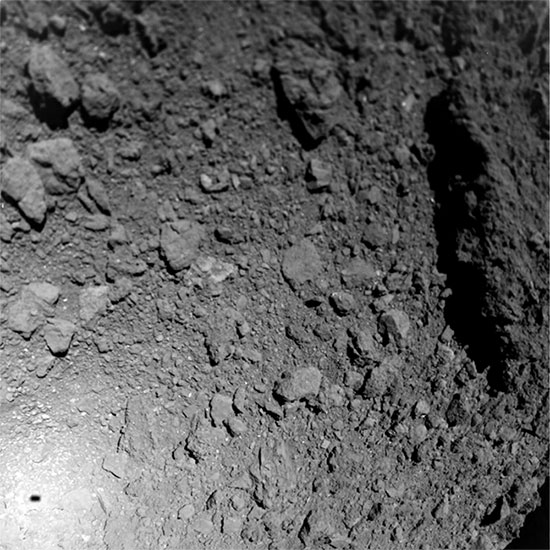New discoveries about Ryugu asteroid near Earth
This asteroid has a diameter of 900m, so the asteroid's gravity is 66,500 times weaker than the Earth.
Photos of the Ryugu asteroid near Earth, taken by MASCOT robot , provide new clues to the asteroid's composition, which is expected to help scientists gain more information about the asteroid. formation of the solar system.
Earlier, the MASCOT robot, which had a box shape, weighed about 10kg, was launched from the Japanese probe Hayabusa 2, landed safely on the Ryugu asteroid on October 3, 2018.
This asteroid has a diameter of 900m, so the asteroid's gravity is 66,500 times weaker than the Earth.

Photos taken from the MASCOT robot.(Source: astronomy.com)
In addition to recording temperature studies and taking other measurements, MASCOT also sent a series of photographs showing Ryugu asteroids covered with two types of stones and pebbles: a rough and dark type. color with a rough surface like cauliflower while the other is bright and smooth.
The researchers identified this as evidence that Ryugu could be the product of "a violent process" when two objects collided and then split, then pulled back by gravity.
Many rocks contain small blue and red matter during the formation process, similar to a rare and precious natural meteorite found on Earth called carbonaceous chondrites .
According to the researchers, this is the primordial material of the Sun's nebula - a cloud of gas and dust that is thought to be the origin of the Solar System.
MASCOT for the first time also provided information about the initial geological condition of the material, including how it was affected when the temperature changed and existed in space. .
Scientist Jaumann said that in order to know how planets formed in the beginning, people had to learn about small planets, early planets that could understand 10 to 100 million years of the first. planet formation.
MASCOT also brings a new mystery to scientists: Ryugu lacks traces of interplanetary dust particles that have accumulated over millions of years in the universe and are thought to be traces related to the early days. formation of the Solar System.
Researchers believe that dust particles may have fallen into small holes on Ryugu's surface as the asteroid collided with another object.
In addition, temperature changes can lead to an electrostatic force that pushes dust particles into space. Or water may have existed on Ryugu, and its evaporation carried small particles of dust.
Researchers also stress that studying asteroids is important because human existence may one day depend on this.
Ryugu revolves around the Sun for a period of 16 months, orbiting the orbit of the Earth and Mars.
Although Ryugu is near the Earth, Ryugu is said to pose no danger to humans, while other asteroids are capable.
If the constituents of other asteroids are similar to Ryugu, trying to deflect the planet's orbit by missiles can only break them into smaller rocks but they still face Earth.
Another approach is to build a "solar sail" and place them on the asteroid's surface to take advantage of the pressure from the solar radiation, thereby causing asteroids to gradually change direction.
It is expected that Hayabusa 2 will return to Earth in 2020 to bring the specimens collected from Ryugu asteroid.
Because it is not affected by the radiation of the universe, the rock in the Ryugu asteroid still retains its original state when it was born from the Solar System some 4.6 billion years ago.
Scientists expect the collection of this stone sample will help decode the formation of the Solar System and test the hypothesis that this asteroid has water and organic substances that form life.
- There are no signs of water and life on Ryugu asteroids?
- The second time Japanese probes kicked down asteroids, sending precious film footage
- There are no signs of water and life on Ryugu asteroids?
- The asteroid discovery robot is hundreds of millions of kilometers from Earth
- Japan is about to drop the last robot on the asteroid
- Japanese explorer ship collects rock samples from Ryugu asteroid
- Japanese spacecraft dropped the last robot on the asteroid
- The Japanese space exploration ship has made great strides in its mission to find the source of life
- Japanese probe brings precious specimens back to Earth
- The asteroid is about to fly closest to Earth in 115 years
- A 2,000-meter asteroid could crash into Earth in the future
- This afternoon, an asteroid will fly over the Earth
- Asteroid 800,000km2 fly near the Earth
- An asteroid has just crossed the Earth
 Van Allen's belt and evidence that the Apollo 11 mission to the Moon was myth
Van Allen's belt and evidence that the Apollo 11 mission to the Moon was myth The levels of civilization in the universe (Kardashev scale)
The levels of civilization in the universe (Kardashev scale) Today Mars, the sun and the Earth are aligned
Today Mars, the sun and the Earth are aligned The Amazon owner announced a secret plan to build a space base for thousands of people
The Amazon owner announced a secret plan to build a space base for thousands of people